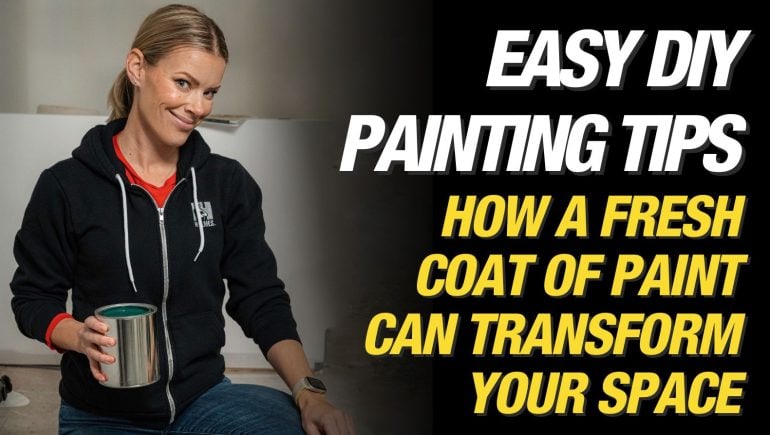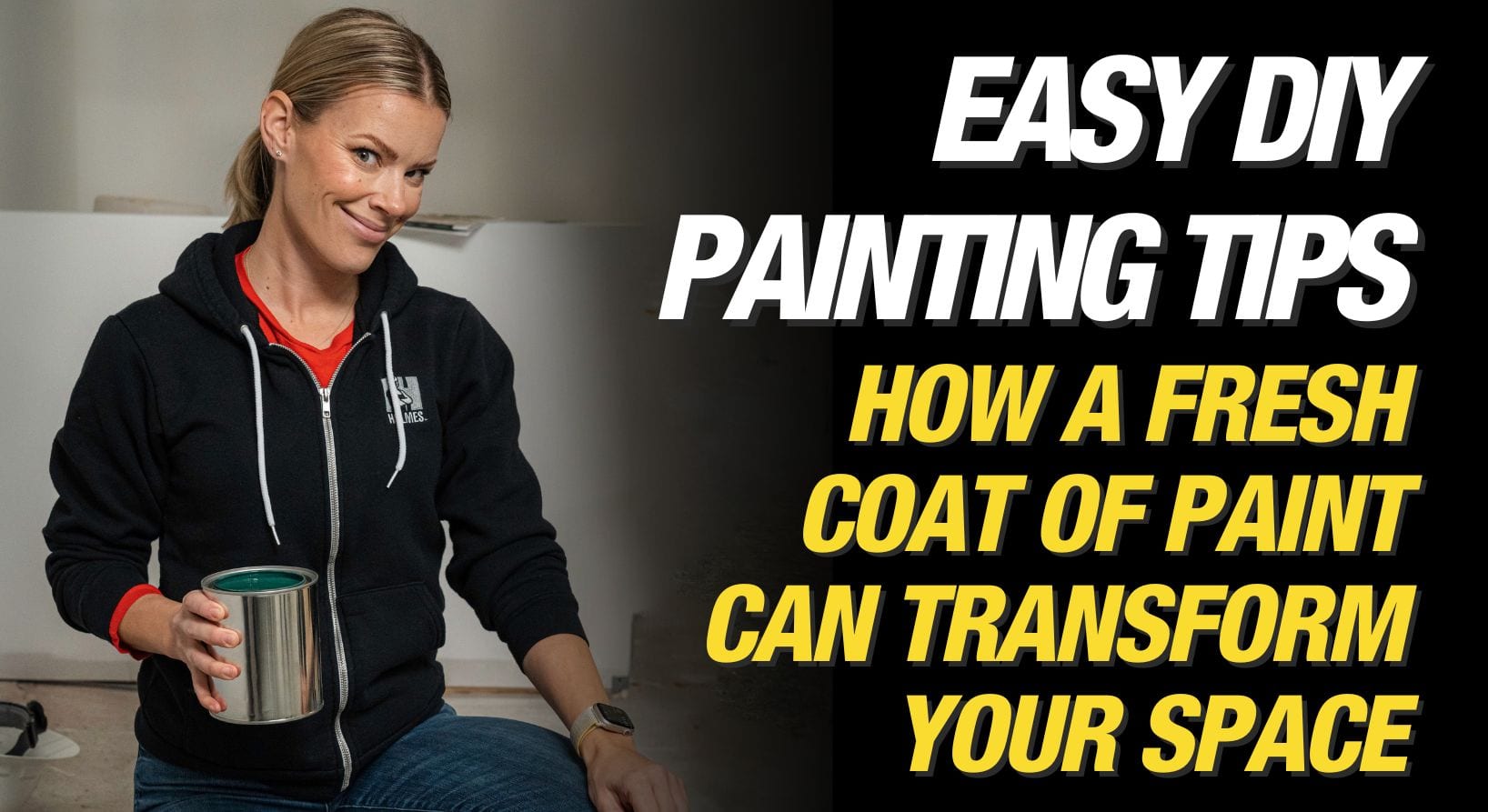When it comes to homes, water is enemy number one, and these 3 exterior home maintenance tasks will help prevent water damage. Water damage is one of the most costly...

Easy DIY Painting Tips: How to Paint a Room Like a Pro
By Sherry Holmes
Mike’s Advice / Buying & Selling Your Home
Monday, February 10th, 2025 @ 1:45pm
How a Fresh Coat of Paint Can Transform Your Space
A fresh coat of paint is one of the easiest and most affordable ways to transform a space. Whether you’re refreshing a tired-looking room, updating your home’s style, or getting ready to sell, a new paint colour can make a big difference and even increase your home’s value. It’s also a fun simple DIY weekend project, which I love to do. Remember, you still need the right tools, preparation, and technique to get a professional-looking finish. That’s why having the right DIY painting tips can make all the difference in achieving smooth, even coverage and a lasting result.
And besides, what’s the worst thing that can happen? You end up not liking the colour, your cut lines need improving or you accidentally step on the paint tray and spill paint (I hope that you remember to cover the floor). All of these are easy fixes.
Here are some easy DIY painting tips to help you paint like a pro and get that smooth, lasting finish!
Choosing the Right Paint Color for Your Space
The colour you choose can completely change the look and feel of a room. Lighter colours can make small spaces feel bigger, especially when walls and trim are painted the same shade. Darker colours, on the other hand, can make a larger room feel cozier and create a more intimate atmosphere.
However, if you are painting your home for resale, experts recommend sticking to neutral colours. These usually appeal to a wider range of buyers.

Not sure which paint colour to choose? Paint a few test squares on your wall and see how they look in different lighting throughout the day!
RELATED
Ready to Design Your Dream Home? 2024 Top Renovation and Design Trends To Consider
How Much Paint Do You Need?
A good baseline to figure out how much paint you’ll need is 4 litres covers about 400 square feet. There are many online calculators to help you figure it out. Running out of paint mid-project is frustrating, so it’s always better to buy a little extra, especially if you plan to do touch-ups later.
I would also recommend selecting a good quality paint. Cheaper paints may require more coats, which means more work and higher overall costs.
RELATED
What You Need to Get Started
If you’ve tackled this type of project before you may have some of the tools already. Just be sure they’re in good condition—old, dried-out brushes won’t give you a smooth finish.
Here are some tools you should have in your paint toolbox before you start:
- Paint and primer
- Brushes and rollers
- Paint trays
- Painter’s tape
- Drop cloths or plastic sheets
- A step ladder for ceilings and high walls

Be sure to have brushes, rollers, painter’s tape, and a quality paint tray on hand for a smooth and professional finish.
RELATED
How to Prep Your Room for Painting
Preparation is key to a smooth, professional-looking paint job. The first step is clearing the room as much as possible. If you’re painting the ceiling, everything should be moved out. If you are just doing the walls, you may be able to get away with just moving things away from the walls.
Next, clean the walls to remove dust, dirt, or grease that could affect paint adhesion. A simple wipe with a damp cloth is usually enough, but for kitchens or homes with smokers, a mild soapy solution works best to remove grease and film. Also, take this time to fill in nail holes and dents with compound, then sand smooth for an even surface.
You can roughen up the wall to help the paint adhere to the surface but I would typically recommend a coat of high-quality primer, especially if you are going with a lighter colour than previously on the wall.
Last but not least, tape off trim, edges of baseboards, and outlet covers to ensure clean lines and a polished finish.
Easy DIY Painting Tips for a Smooth Finish
Once the prep work is done, it’s time to start painting.
1. Painting the Trim & Baseboards
If you’re painting these areas, do them first before starting on the walls. Once dry, tape them off to protect them when painting the walls.
2. Cutting In the Edges
Use a brush to paint along the ceiling, baseboards, and corners before rolling the larger areas. Avoid pushing too far into corners, as this can leave visible brush marks on the adjacent wall.
Painting the edges with a brush first will help the paint blend when applying paint to the larger areas with a roller.
3. Rolling the Walls
Work in small sections, rolling in a “V” or “W” pattern to spread the paint evenly. This also helps keep edges wet and to avoid overlapping. Rolling from top to bottom helps prevent streaks.
4. Applying a Second Coat
Once the first coat is dry, check if another coat is needed. Most walls require two coats for even coverage.
The first coat should be painted in the direction of the window, while the second should go in the opposite direction to ensure full coverage.
READ MORE
Avoiding Common Painting Mistakes
Even with good technique, mistakes can happen. Here are a few common pitfalls and how to avoid them:
- Not protecting floors and furniture – Always use drop cloths, even if you’re careful. Paint splatters are inevitable, and they’re a pain to clean up.
- Overloading the brush or roller – Too much paint leads to drips and uneven application. Dip the brush lightly and roll off excess paint before applying.
- Painting over a drying area – Going over an area that’s already drying can leave streaks. Wait for the first coat to dry before touching up.
- Skipping the primer – If you’re switching from a dark to a light colour, always use a primer to prevent the old colour from bleeding through.
RELATED
Giving some of the rooms in your home or cottage a refresh with a new coat of paint can be a great DIY project. Some of the most popular rooms for a colour change are kitchens, bathrooms and entryways but I’m pretty sure there are lots of teenagers wanting to change the colour of their bedrooms too.
Remember, the key to success is proper prep, patience, and the right techniques. Make sure you have all the tools you need, follow the correct painting order, and take your time. A little extra effort upfront will give you a smoother, more professional-looking finish. Be patient, take your time and have some fun too.
READ MORE
Brick Staining vs Painting. Which one is better?








